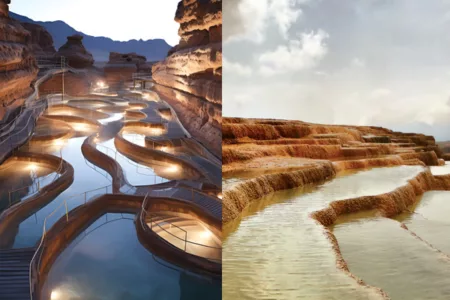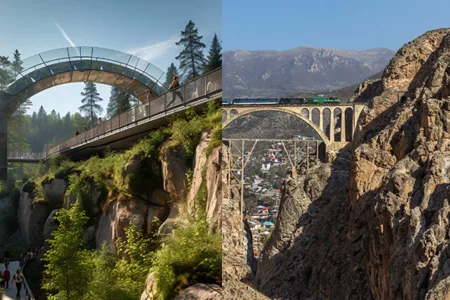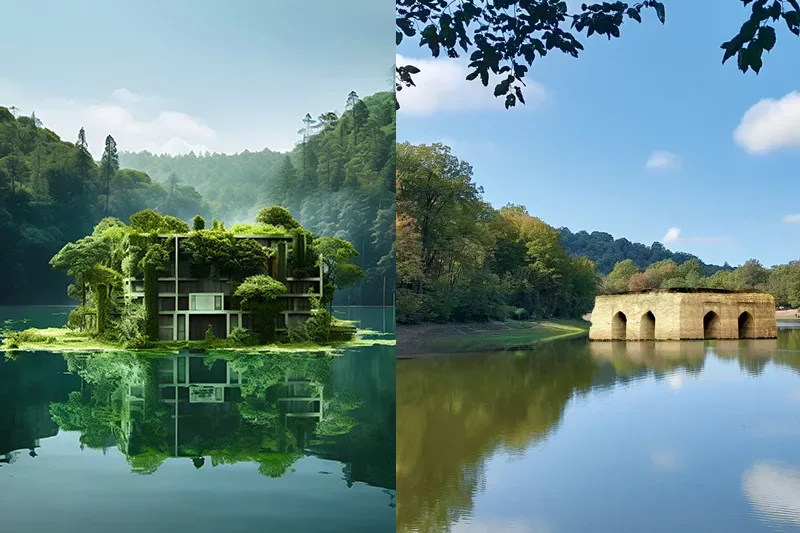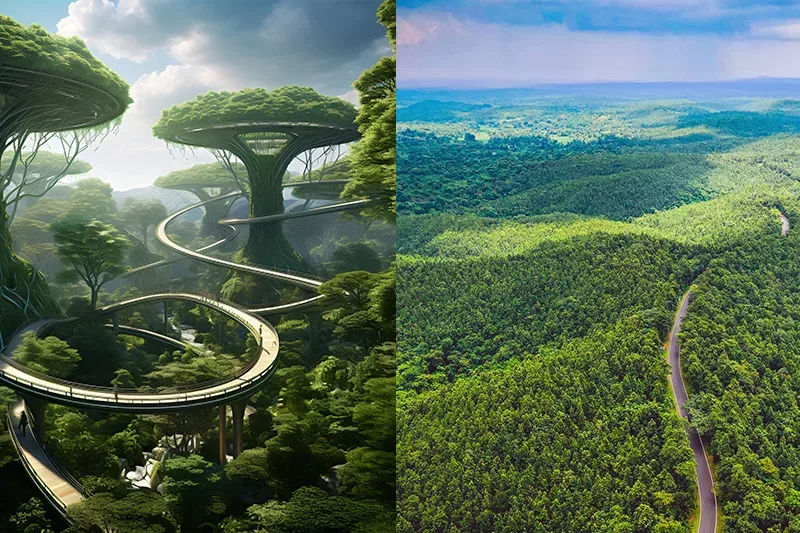
وبلاگ سپهران | Artificial Intelligence | Mazandaran Attractions from ChatGPT’s Point of View
We provided ChatGPT with a list of Mazandaran Attractions along with instructions for writing and asked it to write for us. In the next step, we gave prompts to discord.com to generate photos of Mazandaran attractions in the far future 200 to 500 years from now. The result was that you see; descriptive content of each attraction along with a photo that Discord generated for us, as well as a current, real photo of that attraction. It is an interesting comparison. Don’t miss this Sepehran blog article.

Badab Soort also known as Badab-e Surt is a natural attraction located in Mazandaran Province, in northern Iran. It is a series of terraced travertine structures formed by the cooling of mineral-rich warm springs and carbonated mineral springs on the slopes of the mountain. These two hot springs are located at the base of the mountain range and are distinguished from other areas by their colors: one is orange and slightly acidic, while the other is yellow and slightly alkaline.
Since 2018, this area has been protected by UNESCO and is divided into two separate parts: the lower part with the two springs that feed the terraced travertine formations, and the upper part with a small lake surrounded by a forest cover.
The terraced travertine formations are made up of calcium carbonate deposits from the spring water and have rusty red to creamy color terraces over time. You can see a breathtaking view from the top of its highest terrace, and overlook the entire expanse of the area. The surrounding area is also a habitat for bird species and other animals, making it an ideal place for birdwatching or enjoying stunning nature. There are multiple hiking trails that lead up the mountain and offer scenic views along the way.
The best time to visit Badab-e Surt is during spring and autumn when the weather is mild and suitable for travel. This area is also renowned for its beautiful natural landscapes. Visitors can enjoy the serene environment and admire the breathtaking views.

Varesk Bridge is one of the most beautiful and famous historical bridges in Iran and a masterpiece of modern engineering in the country. The purpose of its construction was to establish a railway route to northern Iran. The bridge was built in a period of two years and was inaugurated in 1936. Varesk Bridge, located on the Tehran-to-north railway route, played a crucial role in the outcome of World War II. Without this bridge, the course of the war would have been different.
Situated near the village of Varesk, on top of the Varesk valley, and between two large mountains in Abbasabad, Varesk Bridge lies on the Tehran-to-north railway route. This bridge, considered one of the attractions of Savadkuh County, is the largest railway bridge in the northern part of the country and is currently used for the passage of passenger trains from Tehran to Gorgan, Tehran to Sari, and freight trains. It stands at an elevation of 2,140 meters above sea level, with a height of 110 meters from the valley floor.
Varesk Bridge is one of the most valuable railway engineering structures in Iran, and its construction was undertaken by a Danish company. The bridge was built using simple tools, such as manual drills. Interestingly, no metal structures were used in the construction of the Varesk Bridge. The beautiful scenery surrounding the bridge in the Alborz Mountain Range entices every traveler to pause for a short while and enjoy the view. In 1977, Varesk Bridge was registered as a national monument.
Take the opportunity to visit the Varesk River and enjoy the cool weather and beautiful landscapes of the area. Varesk Waterfall, located near Varesk Bridge, can also be included in your travel itinerary. The waterfall is situated east of the village of Varesk, and the best time to visit is during spring and summer.

Chalus Road, officially known as Route 59, is the fourth most beautiful road in the world and one of the most popular routes in Northern Iran. This road presents an extensive panorama of unique natural, historical, and tourist attractions. In addition to its stunning landscapes, waterfalls, and springs, there are various historical sites along this road. Chalus Road is more than just a thoroughfare; it is an astonishing sightseeing rest stop that leaves unforgettable moments in your memory. The tourist, recreational, and sports facilities of Chalus Road have made it a significant destination for travelers.
Built in 1933 during Reza Shah’s reign, this busy and picturesque route was deemed impossible to construct given its geographic location, but after its completion, it turned into an engineering marvel of its time. The road displays diverse landscapes, from lush nature to snow-covered paths, mountainous terrains, and a stunning view of Northern Iran. Chalus Road is typically open all year round, but during the winter months, when the road is covered with snow, it becomes challenging and even sometimes impossible to traverse.
Chalus Road stretches over 160 kilometers (100 miles), starting from Alborz province and extending to the city of Chalus in Mazandaran province. Several tunnels are located along its path. In addition to its unmatched beauty, this road can be very dangerous for novice drivers. Its numerous bends, narrowness, and mountainous terrain make it hazardous for those lacking sufficient experience in driving on difficult roads.

The Abbasabad Forests are located in the Mazandaran province of Iran. This protected area encompasses approximately 500 hectares. The majority of its vegetation cover is composed of Oak, Maple, Hornbeam, and Walnut trees. The forest serves as a habitat for various animals such as deer, wolves, foxes, boars, and bears. In addition to its natural beauty and rich biodiversity, the Abbasabad Forests provide the main source of timber needed by local communities. The site consists of two national parks and four wildlife sanctuaries managed by the Iranian Department of Environment.
In the Abbasabad Forests, you can engage in various recreational activities such as camping, hunting, fishing, hiking, horseback riding, and bird watching. The climate in Abbasabad is generally hot, eastern, and humid. The area experiences hot and humid summers, with temperatures reaching up to 40 degrees Celsius. Its winters are cold and dry, with temperatures ranging from -5 to 10 degrees Celsius. There are three main ways to access the Abbasabad Forests in Mazandaran:
With a history of over 400 years, this forest is one of the oldest in Iran. It is said that Shah Abbas I of the Safavid dynasty ordered its creation. He intended to establish a wildlife refuge and, at the same time, secure the supply of timber needed for the country’s naval force. Later, Nader Shah Afshar also ordered the expansion and protection of the Abbasabad Forests. Ultimately, these forests became a recreational area for tourists, with the construction of a road from Tehran to the Abbasabad Forests making it possible for everyone to enjoy its lush nature.
Several lodges were built in the area to accommodate tourists. These days, the Abbasabad Forests are a popular destination for visitors. Noteworthy places in the Abbasabad forest site include Abbasabad Natural Lake, Shah Abbasi Dam, a brick tower, and a water mill.

The Hyrcanian forests of the Caspian form a unique forested massif that stretches, 55000 square kilometers near the southern shores of the Caspian Sea, covering the northern provinces of Iran and extending into the Republic of Azerbaijan. Named after the ancient region of Hyrcania, ‘wolf land’, these forests are among the oldest in the world, perhaps being a remnant from the tertiary age (up to 50 million years ago) which avoided the Ice Age.
In 2019, the Hyrcanian forests were inscribed as a UNESCO World Heritage Site, and they are home to a rich variety of flora and fauna species. The local communities have always considered the forests as a valuable resource. Unfortunately, the rich biodiversity of this forest is under serious threat due to deforestation and agricultural activities. In recent years, substantial efforts have been made to conserve and restore the Hyrcanian forests, including the establishment of protected areas, tree planting, and the implementation of sustainable forestry practices. As a result, the forest is gradually recovering and being restored.
The Hyrcanian forests form a unique forested massif along the southern coasts of the Caspian Sea. The history of these broad-leaved forests dates back 25 to 50 million years. These ancient forest areas retreated during the Quaternary glaciations and then expanded again as the climate became milder. 44% of the known angiosperm plants in Iran are found in the Hyrcanian region, which covers only 7% of the country. To date, 180 bird species and 58 mammal species have been identified in these forests.
The Hyrcanian forests stand out from other forests worldwide due to their large extent, rich biodiversity, and unique plant cover. Trees such as Oak, Beech, Alder, and Walnut, are abundant in this region. These forests are home to various animal species, including wild boar, red deer, fox, wolf, and brown bear. Many bird species, including woodpeckers, owls, and eagles, also live in these forests. Furthermore, the dense forest canopy protects from severe winter temperatures and strong winds.
The climate of the Hyrcanian forests is semi-humid subtropical, with warm and humid summers and cool and mild winters. The average temperature range is between 10 degrees Celsius (50 degrees Fahrenheit) and 30 degrees Celsius (86 degrees Fahrenheit), and the region has an annual rainfall of about 1000 millimeters (39 inches).

Ramsar, a gem nestled within the province of Mazandaran, Iran, stands as a luxurious getaway on the shimmering shores of the Caspian Sea. This delightful urban landscape, adorned with verdant trees, possesses a unique charm that effortlessly captures the heart of every traveler. In this city, the symphony of the Caspian’s roaring waves and the cool breeze from the forest brings about a refreshing atmosphere of tranquility.
Admired by Iranian and international tourists, Ramsar houses an unparalleled range of opulent hotels offering unrivaled comfort and top-notch global services. These hotels, surrounded by the blue vista of the sea and verdant forest landscapes, promise guests a close connection with nature without ignoring their luxurious lifestyle.
Beyond the walls of its plush accommodations, Ramsar showcases its beauty in the form of magnificent natural landscapes. From the breathtaking views atop the surrounding mountains to serene gardens with vibrant colors, nature lovers are always entranced by the natural beauty of Ramsar.
Ramsar welcomes its guests to experience a blend of Iran’s rich heritage and natural beauty. Travel to Ramsar; promises an unforgettable journey to Iran’s tranquil paradise. This Caspian city of Mazandaran province, nestled between the Alborz mountains and the Caspian Sea, attracts many Iranian and international tourists year-round, thanks to its temperate climate. The sights in Ramsar range from historical and natural to recreational and cultural.
All of these are just part of the attractions that Ramsar, a popular tourist destination, offers you. A trip to Ramsar is an excellent experience for any traveler who has chosen this city as their destination.

Undoubtedly, Filband is one of the most astonishing destinations in Iranian nature you have ever seen. Imagine being on the edge of the sky, where hills and clouds meet, and they observe the sun slowly sinking into eternity. That’s the beautiful image you can feel about Filband.
Filband is a village near the city of Babol in Mazandaran province, which they call Filban. This pleasant climate highland is located on hills at an altitude of over 2300 meters above sea level. Therefore, in this unique place, you can enjoy watching an endless ocean of clouds. Watching the movement of clouds under your feet is the most popular attraction in Filband. In fact, it’s not the clouds that are under your feet, it’s you who are standing above the clouds watching their movement.
Filband is a paradise for nature lovers and mountaineers, especially in the summer and spring, when the weather is excellent. You might be lucky enough to see a rainbow after a gentle rain.
The best time to travel to Filband is summer when the freshness and greenery of Filband nature reach their peak. However, since this village has harsh winters, usually no traveler sees it in the cold season.
There are two ways to get to this dreamy village. You can go to Filband via the Babol road, but the route is very scenic, so choose this road only if you want to go to Filband with one of the off-road cars.
The second way is the Haraz Road and the Sangchal-Amol Road, which can be a more convenient and comfortable route for you. Go towards the Haraz road from Amol and after 2 kilometers, pass through the tunnel until you see the signboard of Chelav Rural District road on your left. After passing this village, you will reach the lush highland of Filband.
Filband is a destination for mountaineers and nature lovers, so it has few restaurants, and those few also serve local Mazandaran dishes. Heli No restaurant and Rasouli restaurant are among the restaurants in Filband. This highland does not have a hotel, but if you plan to stay one or two nights, the homes of native communities are the best choice.

Absolutely, without a doubt, Namakabrud is one of the most astonishing destinations in Iran. Imagine standing at the edge of the sky, where hills and clouds meet, and watching the sun slowly descend into the horizon. This is the beautiful view you can experience in Namakabrud.
Namakabrud is a tourist destination located in the central district of Chalus in Mazandaran province. It attracts many visitors from all over Iran and citizens of some neighboring countries. This city, more like a resort, is located 12 kilometers from Chalus and consists of two residential and tourist areas.
The residential part of Namakabrud consists of eight neighborhoods that can accommodate up to a hundred thousand (100,000) tourists in total. Various recreational facilities such as aerial tramways, adventure parks, and surfing are available at the entrances to the residential area. Moreover, two forest parks, Banafsheh and Shemshad, located in the north of the complex, provide a picturesque and scenic space for visitors with about 200 hectares. Like all forest parks, Namakabrud’s forest parks are habitats for various plant species such as Ash, Hornbeam, Ulmus glabra, and Fraxinus some of these trees are more than 700 years old.
The aerial tramway route of Namakabrud, which is one of the reasons for attracting tourists to this destination, starts from sea level near the Caspian Sea coast and crosses the Hyrcanian forests to reach Alborz Heights. The view of northern Iran’s nature and the Alborz Mountains from above the Namakabrud cable car also offers a fantastic landscape. This cable car goes up to 700 meters above sea level. The presence of several restaurants and a variety of recreational facilities in its surrounding environment interests any tourist to this site.
If you intend to experience a delightful and exciting stay, but the travel time is short, the Namakabrud rest area can be a suitable choice for you. This rest area, with the most varied attractions in a peaceful environment and excellent climate, is an attractive suggestion for any tourist who is looking for fresh air, beautiful sea views, and an indescribable forest landscape for a trip to Namakabrud.
How was the result?
You have read the result of working with artificial intelligence about Mazandaran Attractions. We hope you enjoyed what ChatGPT wrote and what Discord made. If you are planning to visit Mazandaran attractions and their breathtaking sceneries, in addition to reading related posts about the destinations, select the best and most convenient way to travel; book a flight on the Fly Sepehran website.